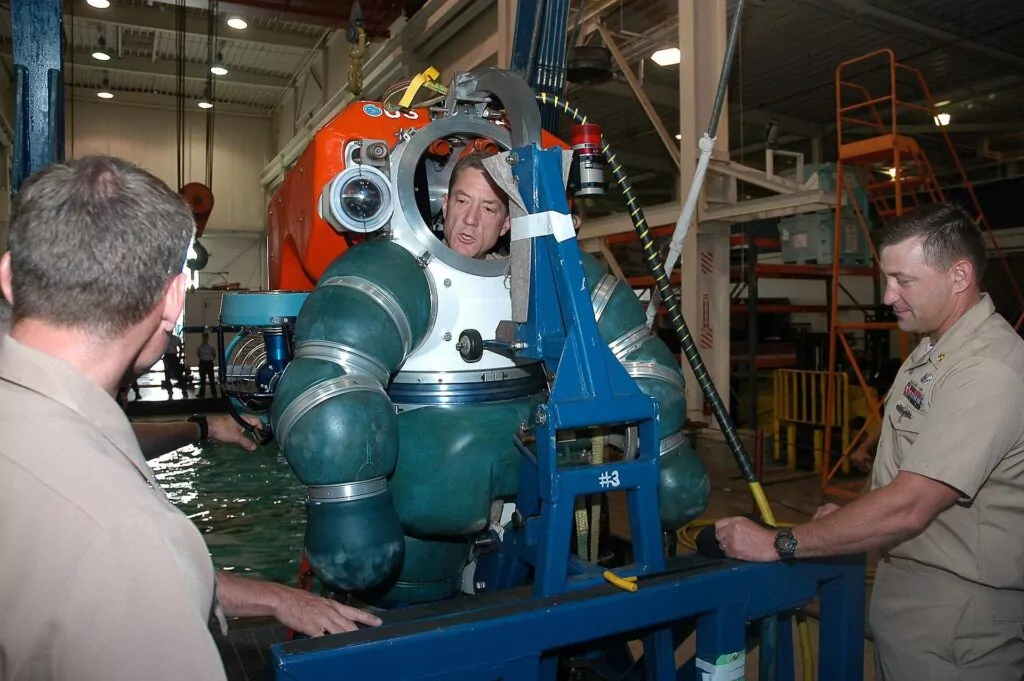It might seem a far cry from recreational scuba, but advances in extreme diving often filter down to sport divers in time – sometimes in unexpected ways.
The DSEND diving suit being developed by the US Navy could herald a new generation of flexible “smart armour” that allows divers to take a one-atmosphere environment to work with them – a tantalising prospect for technical wreck divers looking for extended bottom times followed by a swift but safe ascent.
“DSEND is truly a game-changer, because it’s a self-contained environment that keeps internal pressure steady as a diver descends to depths with increasing external pressure,” explained Dr Sandra Chapman of the Office of Naval Research (ONR).
“It increases diver safety, allows them to expand the operational envelope and would eliminate lengthy decompression times.”
The ONR’s function is to maintain the Navy and Marine Corps’ technological advantage, and it believes it has found a means of doing that in its Deep Sea Expeditionary with No Decompression (DSEND) system.
It’s a hardened yet lightweight atmospheric dive-suit with rotating, detachable joints that are said to allow for greater dexterity, flexibility and manoeuvrability, and its capabilities have been shown off recently at a Naval Surface Warfare Centre in Maryland and at Florida’s Navy Experimental Diving Unit.
During the demonstration, surface-supplied DSEND divers completed exercises that included pulling a mannequin from an aircraft fuselage, rigging a piece of wreckage for salvage and traversing makeshift tunnels representing sunken vessels.
Underwater rescues
Naval diving missions can include deep-ocean salvage of vessels and aircraft, underwater rescues, explosive ordnance disposal, ship-hull maintenance and recovery of sunken equipment. When working at depth the divers often need to offset the risks and discomfort through use of a saturation system, with the pressure inside their diving bell set to match external pressure.
Having to ascend slowly with lengthy decompression stops is a costly way of working in terms of time and money, as is also the case for commercial saturation divers, but the DSEND self-contained life-support system gets round that, says the ONR.
“Because DSEND maintains one consistent pressure atmosphere, the diver is never exposed to the negative physiological effects associated with deep diving, such as decompression sickness, cold and wet exposure,” said Paul McMurtrie, diving systems program manager of Naval Sea Systems Command. “A diver can work for long periods of time in deep water and rapidly return to the surface.”
Atmospheric diving suits traditionally used by the Navy in the past were more rigid and had to be powered by attached thrusters, making it difficult for the diver to move around.

Although DSEND is constructed from hard, durable materials it is said to be lightweight and to enable divers to swim or walk on the seabed easily.
It is also said to be easier to don and remove, and can be adjusted to suit the diver’s size. Joints, grippers and hand-attachments made from new strong but lightweight materials are said to allow the diver to mirror the natural movements of human joints, and so reduce fatigue over extended work periods.
Sensorised suit
“DSEND will allow divers to conduct harder missions by going deeper, executing faster and operating longer, all while being protected by a sensorised suit of armour,” said Naval Undersea Warfare Centre research engineer Tom Hansen. “It feels like we’re developing the futuristic smart armour you see in movies.”
There seems to be some way to go yet in terms of pressure resistance, because the DSEND as demonstrated is rated to little more than 90m. However, Dr Chapman said that she hoped to see the ONR demonstrate a further-developed DSEND in realistic undersea operating environments later this year.
Also on Divernet: Has Anyone Seen JIM?, New Websites Dive Into History, Under Pressure, Can Underwater Living Turn Dr Deep Sea Superhuman?

